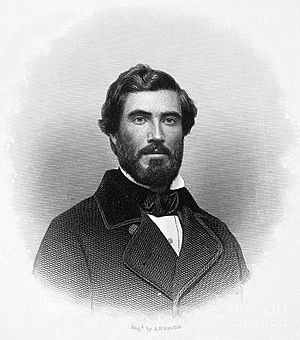Hinton Rowan Helper facts for kids
Hinton Rowan Helper (born December 27, 1829 – died March 9, 1909) was an American writer. He was known for his strong views against slavery, but he also believed that America should be a country only for white people. In 1857, he published a book called The Impending Crisis of the South: How to Meet It. He wrote this book for the white people in the South who did not own slaves.
Helper's book argued that slavery actually hurt the economy for everyone in the Southern United States, especially for those who didn't own slaves. He believed slavery stopped the South from growing and becoming wealthier. People in the South became very angry about his book. They thought he was trying to divide Southerners by making poor whites turn against rich slave owners. This anger led to strong criticism of "Helperism."
Contents
Helper's Early Life and Ideas
Hinton Rowan Helper was born near Mocksville, North Carolina. His family name was originally "Helfer," and his grandfather came from Heidelberg. Helper's father was a small farmer who owned slaves, but he died before Helper was one year old. Even so, Helper was cared for by his wealthy relatives. His uncle helped him get a good education. He finished school at Mocksville Academy in 1848.
In 1851, Helper traveled to California, hoping to find gold and get rich. But he came back in 1854 feeling disappointed. In 1855, he wrote a book called The Land of Gold. Reality versus Fiction. In this book, he wrote that using slave labor was less profitable than using free labor. When he tried to publish the book in Baltimore, he ran into a law from 1831. This law made it a serious crime to write or print anything that might cause "discontent" among people of color.
Because of this law, Helper had to remove those parts from his book. This made him very determined to share his full thoughts on the subject. So, he decided to write a whole new book about it. This new book was The Impending Crisis of the South: How to Meet It.
His Famous Book: The Impending Crisis
Helper's book, The Impending Crisis of the South, showed his strong opposition to slavery. He believed slavery was holding back the South's culture and economic growth. He used facts and figures from the census to prove his points. For example, he showed that land values, how many people could read, and how much manufacturing was happening were all much lower in the South compared to the North. He also warned that slavery was causing harm to the environment, like through deforestation.
Helper suggested that slave owners should be taxed. He wanted this money to be used to send all free Black people to Africa or Latin America.
The Impending Crisis in the South made Helper famous very quickly. It also made the political situation worse. Southerners became afraid that poor white people in the South might turn against slavery if they realized it wasn't helping them. This fear of division among white people led many Southerners who had not supported leaving the United States to change their minds. They began to support leaving the Union after Abraham Lincoln was elected president.
The Impact of The Impending Crisis
Helper's book mixed statistics with strong writing. It didn't get much attention at first. But in 1859, a shorter version called the Compendium was widely printed by people in the North who opposed slavery. Helper's main idea was that slavery hurt the Southern economy. He believed it stopped the South from developing industries. He argued this was why the South had grown much less than the North, according to the 1850 census. Helper said he was speaking for the majority of Southern white people who were not wealthy. He felt they were being held down by a small group of rich slave owners who had a lot of political power.
The reaction to the book in the South was very negative. It was against the law to own or share Helper's book there. Authorities would burn copies they found. Even so, between 1857 and 1861, nearly 150,000 copies of the book were shared. In 1860, the Republican party used it as part of their election campaign. In December 1859, Democrats in Congress were very angry. This was because 68 Republicans had supported the book and planned to use it in the 1860 presidential election. Opponents even stopped Republican John Sherman from becoming speaker of the House because he had supported the book.
Helper's book focused on slavery as an economic system. It did not talk much about Black people themselves.
Life After the Civil War
After the Civil War, Helper continued to express strong views. He wanted all former slaves to be sent out of the country. He believed the United States should be a country only for white people. This included excluding Chinese people, Native Americans, and other non-white groups. His dislike of Black people became very extreme. He would not even go to hotels or restaurants that employed Black people.
Even though Helper had been against slavery, many Southerners who opposed Reconstruction after the war did not forgive him. He remained a less important and increasingly unstable person in America after the war.
President Lincoln appointed Helper as the United States consul in Buenos Aires from 1861 to 1866. After the war, Helper spent most of his time trying to get support for a huge railroad project. He wanted to build a railway connecting North and South America. He believed this railway would help replace Black and brown populations with white people. This "Three Americas Railway" was supposed to stretch from the Bering Sea to the Strait of Magellan. However, his plans for this railroad never happened.
Later Life and Death
Hinton Rowan Helper died on March 9, 1909, in his apartment in Washington, D.C..
Remembering Helper
- The Hinton Rowan Helper House was where Helper lived from 1829 to 1849. It is now a special historical place called a National Historic Landmark.
- A Liberty ship was named SS Hinton R. Helper.
Helper's Writings
- Various editions of The Impending Crisis
- The Impending Crisis of the South: How to Meet It (1860 edition) online version
- The Impending Crisis of the South: How to Meet It (1968). Edited by George M. Fredrickson.
- The Negroes in Negroland; The Negroes in America; And Negroes Generally. Also, the Several Races of White Men, Considered as the Involuntary and Predestined Supplanters of the Black Races (1868). Published in New York by G.W. Carleton.



